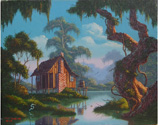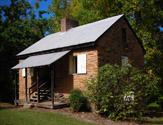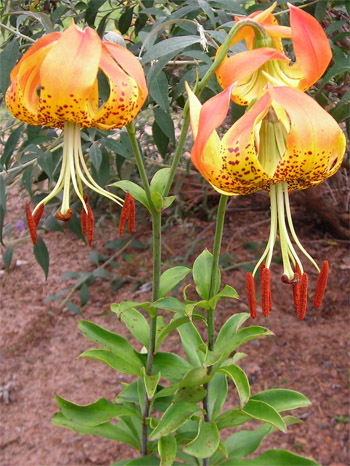















Magnolia Eden
The Carolina Lily
Michaux's Discovery Still Prized by Gardeners
Michaux's Discovery Still Prized by Gardeners
Among the native North American plants catalogued by French botanist André Michaux (1770-1855) is Lilium michauxii, a beautiful lily named in his honor by fellow botanist and explorer Jean Louis Marie Poiret (1755-1834). Commonly known as the Carolina lily, this plant grows primarily in upland pine-oak woods, and can be found from Virginia to Texas, even growing as far south as Florida (near the Georgia border). The lily is the official wildflower of North Carolina.
Growing one to four feet in height, L. michauxii prefers moist, well-drained soil and partial shade with only two hours or so of sun exposure each day.
For several weeks between May and August, the Carolina lily presents a wonderful display of drooping flowers that are characterized by their half dozen reddish-yellow reflexed petals with spots at the base. The whorled obovate leaves of L. michauxii distinguish it from similar species which feature lanceolate leaves.
The anthers of the Carolina lily boast copious amounts of brownish-burgundy pollen, but self-fertilization is impossible due to a flower's ability to reject its own pollen. Pollination is dependent upon insects, particularly bees and bumblebees, which transfer pollen from one flower to another.
Growing one to four feet in height, L. michauxii prefers moist, well-drained soil and partial shade with only two hours or so of sun exposure each day.
For several weeks between May and August, the Carolina lily presents a wonderful display of drooping flowers that are characterized by their half dozen reddish-yellow reflexed petals with spots at the base. The whorled obovate leaves of L. michauxii distinguish it from similar species which feature lanceolate leaves.
The anthers of the Carolina lily boast copious amounts of brownish-burgundy pollen, but self-fertilization is impossible due to a flower's ability to reject its own pollen. Pollination is dependent upon insects, particularly bees and bumblebees, which transfer pollen from one flower to another.

Lilium michauxii, also known as the Carolina lily
Author's Note: Though Lilium michauxii prefers a limited amount of direct sunlight, my specimens (pictured above) have adapted to my full sun garden. They receive several hours of full sun in the morning, but are partially shaded by Buddleja shrubs and a trellised Lonicera in the afternoon when the heat and exposure is most intense.
The Journey of André Michaux
André Michaux was a prolific botanist, whose accomplishments remain significant well over a century following his death. A number of Michaux's discoveries or plant introductions from other countries have forever impacted the American landscape.
In his book, Gardens and Historic Plants of the Antebellum South, James R. Cothran wrote, "By way of a commission from Louis XVI, Michaux came to America along with his son, Francois, in 1785 to collect flora from North America that had potential economic value to France." Within days of arriving in New York, Michaux began collecting plants in nearby New Jersey. Finding the warmer climate of the American South more conducive to growing and propagating his native plant discoveries and various introductions from other lands, Michaux relocated to South Carolina in 1786, acquiring 111 acres just outside Charleston. His "French Garden" served as a nursery and home base for his various North American expeditions over the next decade. Michaux's authoritative Flora Boreali-Americana, a catalogue of plants he observed in North America, was published posthumously in March 1803.
Plants and trees located and documented by Michaux included Rhododendron calendulaceum (flame azalea), Pinckneya pubens (fever tree), Rosa laevigata (Cherokee rose), Cornus asperifolia (rough-leaved dogwood), Houstonia serpyllifolia (Appalachian bluet) and Vitis rotundifolia (muscadine). Michaux's introductions to North America included Camellia japonica (camellia), Albizia julibrissin (mimosa), Lagerstroemia indica (crape myrtle), Osmanthus fragrans (tea olive) and Gingko biloba (gingko).
While the exact location of Michaux's discovery of L. michauxii is not known, his writings indicate that he referred to the flower as L. carolinianum. Michaux likely encountered the Carolina lily in June 1787 or shortly thereafter when he first explored the headwaters of the Savannah River in present-day Oconee County, South Carolina. He probably observed the lily again when he ventured to the Carolina mountains in the summer of 1794, arriving at the foot of Black Mountain on August 10.
Locating and Propagating Carolina Lilies
One need not (and should not!) retrace Michaux's steps in order to obtain Carolina lilies. While L. michauxii is hardly an endangered species (except in Florida), it is essential that wild populations remain unmolested. Additionally, Jan W. Midgley stressed in All About South Carolina Wildflowers that Carolina lilies "are collected by unscrupulous plant dealers, and one should inquire about the source of the plants when purchasing them." While gardeners might not find the Carolina lily readily available at most nurseries, a few specialists offer L. michauxii, including Fayetteville, Georgia-based Nearly Native Nursery, Inc.
Gardeners can increase their stocks of L. michauxii by collecting and planting seeds, using bulb scale cuttings and dividing their increase. However, it takes several years to produce a blooming specimen from seed, and propagating lilies from bulb scales is probably best left to advanced gardeners. Therefore, fall bulb division might be the best option for the average gardener since young bulbs develop from mature bulbs via stolons, making division necessary from time to time.
A Connoisseur's Flower
Though lily hybridizers have produced numerous exciting introductions in recent years, species such as L. michauxii are still coveted by discriminating gardeners and native plant aficionados. Under suitable conditions, the Carolina lily thrives, and is deserving of a prominent place in any connoisseur's collection.
André Michaux was a prolific botanist, whose accomplishments remain significant well over a century following his death. A number of Michaux's discoveries or plant introductions from other countries have forever impacted the American landscape.
In his book, Gardens and Historic Plants of the Antebellum South, James R. Cothran wrote, "By way of a commission from Louis XVI, Michaux came to America along with his son, Francois, in 1785 to collect flora from North America that had potential economic value to France." Within days of arriving in New York, Michaux began collecting plants in nearby New Jersey. Finding the warmer climate of the American South more conducive to growing and propagating his native plant discoveries and various introductions from other lands, Michaux relocated to South Carolina in 1786, acquiring 111 acres just outside Charleston. His "French Garden" served as a nursery and home base for his various North American expeditions over the next decade. Michaux's authoritative Flora Boreali-Americana, a catalogue of plants he observed in North America, was published posthumously in March 1803.
Plants and trees located and documented by Michaux included Rhododendron calendulaceum (flame azalea), Pinckneya pubens (fever tree), Rosa laevigata (Cherokee rose), Cornus asperifolia (rough-leaved dogwood), Houstonia serpyllifolia (Appalachian bluet) and Vitis rotundifolia (muscadine). Michaux's introductions to North America included Camellia japonica (camellia), Albizia julibrissin (mimosa), Lagerstroemia indica (crape myrtle), Osmanthus fragrans (tea olive) and Gingko biloba (gingko).
While the exact location of Michaux's discovery of L. michauxii is not known, his writings indicate that he referred to the flower as L. carolinianum. Michaux likely encountered the Carolina lily in June 1787 or shortly thereafter when he first explored the headwaters of the Savannah River in present-day Oconee County, South Carolina. He probably observed the lily again when he ventured to the Carolina mountains in the summer of 1794, arriving at the foot of Black Mountain on August 10.
Locating and Propagating Carolina Lilies
One need not (and should not!) retrace Michaux's steps in order to obtain Carolina lilies. While L. michauxii is hardly an endangered species (except in Florida), it is essential that wild populations remain unmolested. Additionally, Jan W. Midgley stressed in All About South Carolina Wildflowers that Carolina lilies "are collected by unscrupulous plant dealers, and one should inquire about the source of the plants when purchasing them." While gardeners might not find the Carolina lily readily available at most nurseries, a few specialists offer L. michauxii, including Fayetteville, Georgia-based Nearly Native Nursery, Inc.
Gardeners can increase their stocks of L. michauxii by collecting and planting seeds, using bulb scale cuttings and dividing their increase. However, it takes several years to produce a blooming specimen from seed, and propagating lilies from bulb scales is probably best left to advanced gardeners. Therefore, fall bulb division might be the best option for the average gardener since young bulbs develop from mature bulbs via stolons, making division necessary from time to time.
A Connoisseur's Flower
Though lily hybridizers have produced numerous exciting introductions in recent years, species such as L. michauxii are still coveted by discriminating gardeners and native plant aficionados. Under suitable conditions, the Carolina lily thrives, and is deserving of a prominent place in any connoisseur's collection.
BIBLIOGRAPHY
James R. Cothran. Gardens and Historic Plants of the Antebellum South (Columbia: University of South Carolina Press, 2003).
Joseph Ewan (ed.). Classica Botanica Americana Volume 3: Flora Boreali-Americana (New York: Hafner Press, 1974).
Jan W. Midgley. All About South Carolina Wildflowers (Raleigh: Sweetwater Press, Inc., 1999).
Richard Dwight Porcher and Douglas Alan Rayner. A Guide to the Wildflowers of South Carolina (Columbia: University of South Carolina Press, 2001).
Margaret Mills Seaborn (ed.). André Michaux's Journeys in Oconee County, South Carolina, in 1787 and 1788 (Walhalla, South Carolina: Oconee County Library, 1976).
James R. Cothran. Gardens and Historic Plants of the Antebellum South (Columbia: University of South Carolina Press, 2003).
Joseph Ewan (ed.). Classica Botanica Americana Volume 3: Flora Boreali-Americana (New York: Hafner Press, 1974).
Jan W. Midgley. All About South Carolina Wildflowers (Raleigh: Sweetwater Press, Inc., 1999).
Richard Dwight Porcher and Douglas Alan Rayner. A Guide to the Wildflowers of South Carolina (Columbia: University of South Carolina Press, 2001).
Margaret Mills Seaborn (ed.). André Michaux's Journeys in Oconee County, South Carolina, in 1787 and 1788 (Walhalla, South Carolina: Oconee County Library, 1976).
Author: Greg Freeman. Published February 11, 2010.
Copyright
Southern Edition
All Rights Reserved
Southern Edition
All Rights Reserved
All materials contained on this site, including text and images, are protected by copyright laws and may not be reproduced without prior written permission from the publisher. Where applicable, use of some items contained on this site may require permission from other copyright owners.
Fair Use of text from SouthernEdition.com is permitted to the extent allowed by coypright law. Proper citation is requested. Please use this guide when citing a Southern Edition article.
Contact Greg Freeman or SouthernEdition.comFair Use of text from SouthernEdition.com is permitted to the extent allowed by coypright law. Proper citation is requested. Please use this guide when citing a Southern Edition article.